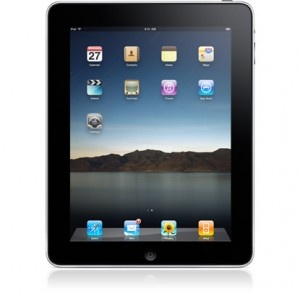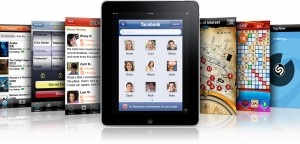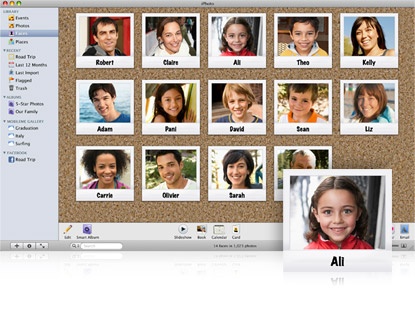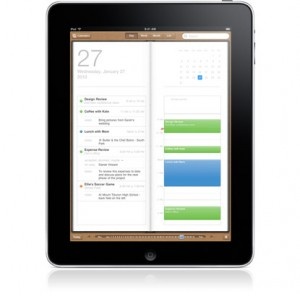Underwhelmed by Apple’s Touch of Creativity

Featuring a 9.7” multitouch display for use with all 10 fingers at once, the iPad looks very similar to an iPhone zoomed up to around 300% scale. The same home button adorns the right (or bottom) of the display depending on if you’re using it in horizontal or vertical orientation, and it’s about half an inch thick, dimensions achieved thanks to Apple’s new custom hardware architecture.
In addition to the usual Apple touch screen apps (Music, Photos, Maps, Calendars), all of which have been customized with fairly stunning interfaces in Apple’s reincarnation of the tablet, iWork has been ported to the touch screen ($10 per application - so $30 if you want to make presentations, write documents and edit spreadsheets on the go) complete with brand new interface designs to make the most of touch, and the huge QWERTY keyboard, which appears to be more suitable for using on the lap with two hands than with rhythmic thumb jabbing as we’ve seen from iPhone and similar devices.
Also featured is Apple’s attempt at an eBook reader, which I didn’t hold out too much hope for before launch. Once again Apple have produced a versatile user interface, using finger actions on screen to turn the page and an ‘App Store’ style book shop with best sellers priced at $14.99, and older novels as low as $4.99 in the industry standard ePub format, wrapped, presumably, in custom DRM.
Third party apps were also on display, with Apple setting a ‘two week’ challenge to a small subset of developers, who got to play with the iPad for two weeks prior to the event and create some prototype applications. EA demonstrated racing on the touch screen with Need for Speed, the New York Times showed a version of their paper with built in video clips and NBA showed a new version of their application with live, full screen match highlights - all fairly standard fare.

That day will be in around 60 days time for the wi-fi model, or 90 for the 3G version. Available in 16GB, 32GB and 64GB capacity models, pricing starts at $499, adding $100 for each storage upgrade, and $130 if you want 3G, making the maximum price $829 for a 64GB iPad with 3G connectivity, and that’s before paying AT&T $14.99 per month for 250MB of data, or $29.99 per month for 1GB. International pricing wasn’t announced at todays event.
Does it really fit?
However, one major problem we have with the iPad is understanding where it’ll fit into your current setup. Do you really need a fourth screen - alongside your TV, phone and laptop - when each of the existing devices already does what the iPad does pretty well. The iPad still needs a laptop to sync, and can’t make phone calls, so you won’t be able to replace one or more of your existing devices.

It also doesn’t meet the standards we expect from our devices, other than the surprising addition of ePub for books, nothing’s industry standard on this new Apple gizmo - you’ll still need to sync with iTunes, and don’t count on finding Amazon MP3 on this device, it’s Apple’s way or no way.
Being locked behind the Apple pay-wall also increases prices - whilst a bestseller on Amazon’s Kindle will set you back $9.99, you’ll be looking at $14.99 from the iBooks store. There’s no mention as to whether you’ll be able to use ePub books from elsewhere, but one would hope Apple would provide this functionality, especially as it’s unclear if indie authors will be able to use the iBooks store to advertise their wares.
We also worry that the device will be too heavy to use single handed, or fragile because of the huge screen that covers the front of the device. Even Steve had to put the iPad on his lap to type, which isn’t ideal for a portable device. As soon as you have to put it down on a flat surface to use it properly, it becomes a lot less like a tablet, and more like a laptop - we expected better from a company that are meant to be the innovators in the mobile marketplace.
Oh, and Apple, multi-tasking would be nice too. The less said about that, the calmer we’ll be.
On The Other Hand
It’s not all bad news for Apple with this new product launch. We’re excited about the single chip system afforded by the in house A4 chip, and wonder what this could mean for future iPhones - although we expect current Apple hardware providers will be crying themselves to sleep tonight over the news that the Cupertino giant won’t be needing their services anymore.
We also appreciate that the full power of this device lies in the hands of the developers, who’ll be best equipped to, with time, take the technology to the next level and hopefully make this device slightly more impressive. The iPad could also attract new developers to the fold, who might decide to make universal applications so iPhone users can have even more variety and selection.

And on a more personal prospective, I hope Apple’s decision to use the industry standard ePub format will force Amazon to follow suit.
Conclusion
Whilst we love that Apple has tried to create this new category of device, we don’t think it’s quite there. There’s still no multitasking, and it’s a tad too expensive if you want to add 3G into the mix. Apple have done everything right that they’ve attempted, but not enough to make us go wow.
This could be another AppleTV for the company - good enough, but never quite making the mainstream. Still, they’ve got a hardware revision next year to prove us wrong.
Until then, we’re sticking to our iPhones and iPod touches.


